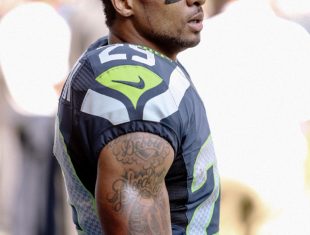TERRY MOSHER
JOHN CLAYTON
If you can figure out the complex salary structure in the NFL, maybe you should audition for Jeopardy. I often hear the Professor, John Clayton, discuss the league salary cap as it pertains to a particular player on his frequent Seattle radio appearances and when he’s done I just shake my head in puzzlement.
The cap was put in place to ensure competitive balance within the league. It prevents big market teams that can produce more gross revenue from buying their way to a Super Bowl championship year after year. Big market refers to the media market because the media revenue is huge. Each team’s market area is about a 75-mile radius from its center.
So the biggest market is New York (Giants and Jets) and the second biggest surprisingly is the Bay Area (49ers and Raiders). Chicago (Bears) and Boston (Patriots) are third and fourth. Seattle (Seahawks) is 17th
The salary cap was instituted by collective bargaining with the players in the league for the 1994 season when it was set at $34 million. It has risen each year since. Monday, the league announced that the cap would be raised from $167 million to $177.2 million for the 2018 season.
That $177.2 million applies to each team and can be spent only on players. Each season all the 30 league teams combined must spend 95 of the cap or more on salaries and if it doesn’t the league must pay the players the remaining amount.
As of 2014, the cap includes gross amount from all sources of league revenue and each team must comply with the cap once the season starts.
From here the complexity of the cap gets so murky that it takes a CPA to unravel. There is, for example, such a thing as “Dead Money” along with cap space and both of these murky items often lead a team either to cut a player or keep a player depending on, well, who knows.
Pursuing through a story by Seattle Times’ reporter Bob Condotta it was discovered that by releasing Richard Sherman the Seahawks saved $11 million against the cap, which was the amount of Sherman’s salary for 2018.
Somehow, and don’t ask me how, but with Sherman signing to play next season with the 49ers the Seahawks take a $2.2 million cap hit.
Bottom line it takes a CPA or a guy like John Clayton, who spends his life studying these things, to understand the cap and other murky consequences of it. Because of all these consequences, teams often release pro bowl players in order to create room in the cap to make other moves they deem more important to their success on the field.
At the beginning of the off-season, Cleveland had the most room under the salary cap of any NFL team. The Browns had over $108 million to spend. Seattle, by contrast, was 24th on the list with about $12.5 million. That figure has obviously been increased with the release of Sherman and Jeremy Lane (freeing up $4.5 million against the cap), the trade of Michael Bennett ($2.2 million saved), and the expected release of Cliff Avril (saving $6.4 against the cap).
The Super Bowl champion Eagles were $11 million over the cap, which means they have work cut out for them to get under it before the season starts.
Baseball has installed a luxury tax to ensure parity. The New York Yankees used to spend like crazy under former owner George Steinbrenner (George died in 2010) and it often seemed unfair. So in 2003 the luxury tax was installed and if a team had a player payroll salary that exceeded the limit set by collective bargaining, it would pay a luxury tax on the overage. Since the tax was installed the Yankees have paid almost $320 million in taxes, which is divided equally among the other teams and players.
This year the limit on players’ payroll is $197 million per team.
The NBA has even a more complex salary cap, which is set at $99 million this season. I can’t even begin to explain it, but I do know that the current bargaining agreement splits league revenue with the players at around 49-51 percent. Then there are a bunch of other things that makes my head spin.
As you might have guessed by now much of the revenue taken in by pro sports’ teams comes from media contracts. Billions and billions of dollars is being spent by ESPN and other media outlets to broadcast their games. These contracts seem to get more pricy each time one is bargained. But there will come a time when the money spigot will be turned off because of other ways consumers can view these games, mainly from Internet streaming.
So one day experts are predicting all these big media contracts will crazy down and professional sports teams may wind up being run out of business. We’ll see about that, but as we all know nothing in life is guaranteed.
Salary cap and aging have caught up with the Seahawks and this off-season the team is going through a rebuilt in the coaching ranks as well as among its players. It’s been like a spring cleaning around the house and where it leads nobody really knows, but a good guess is that Seahawks may wind up falling to the bottom or near the bottom in the suddenly very competitive NFL West. San Francisco and the LA Rams have gotten much better and the Cardinals if they sort out their quarterback situation could be a threat because of its stringent defense.
The timing of the National Hockey League coming to Seattle for the 2020 season is really good, when you think about the possible demise of the Seahawks and the continued struggle of the Mariners to be relevant in the American League West that has the big bully Houston sitting on top and the Los Angeles Angels that have beefed up.
So let’s all go out and buy some skates and hit the ice.
Hey, it’s a great day with the sun actually shining through here in the Pacific Northwest, so I’m outta here.
Be well pal.
Be careful out there.
Have a great day.
You are loved.






